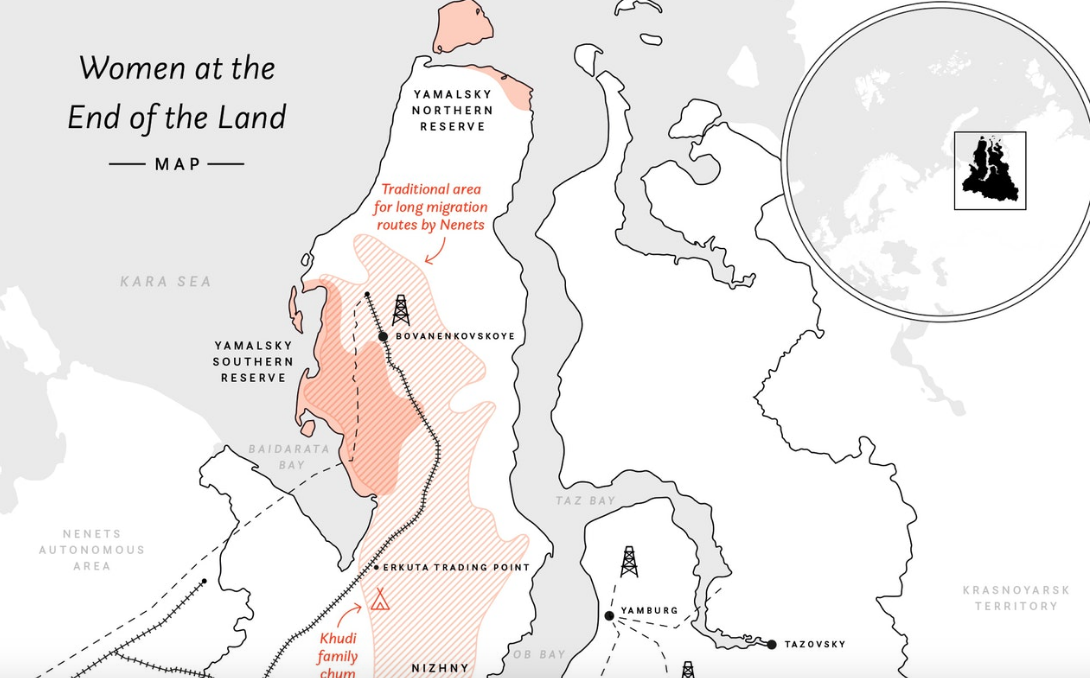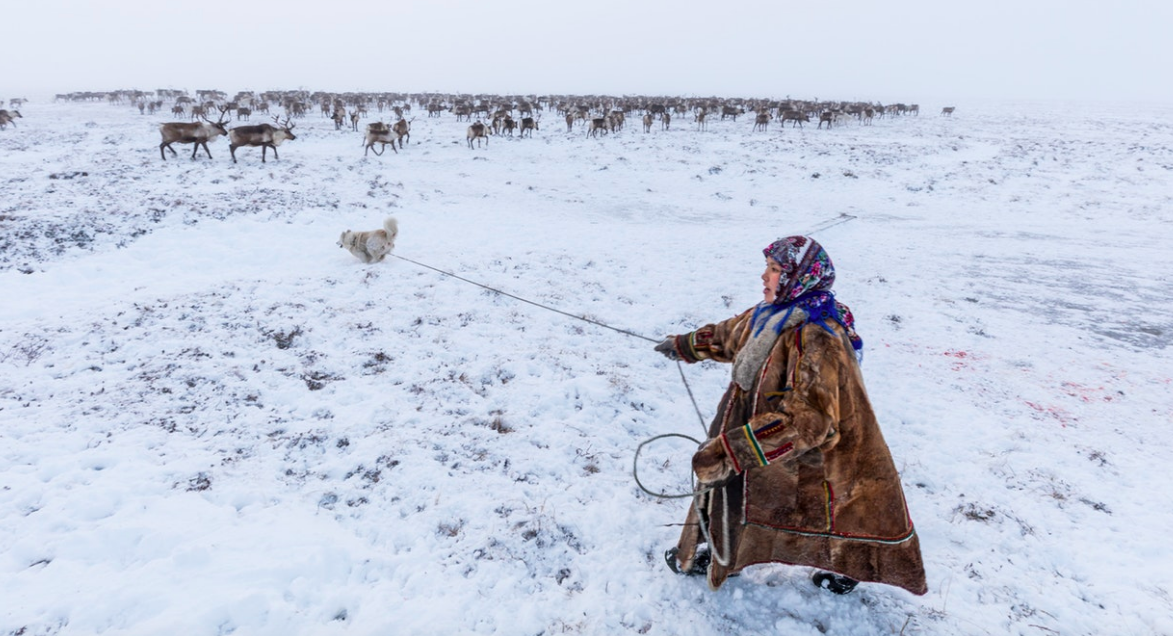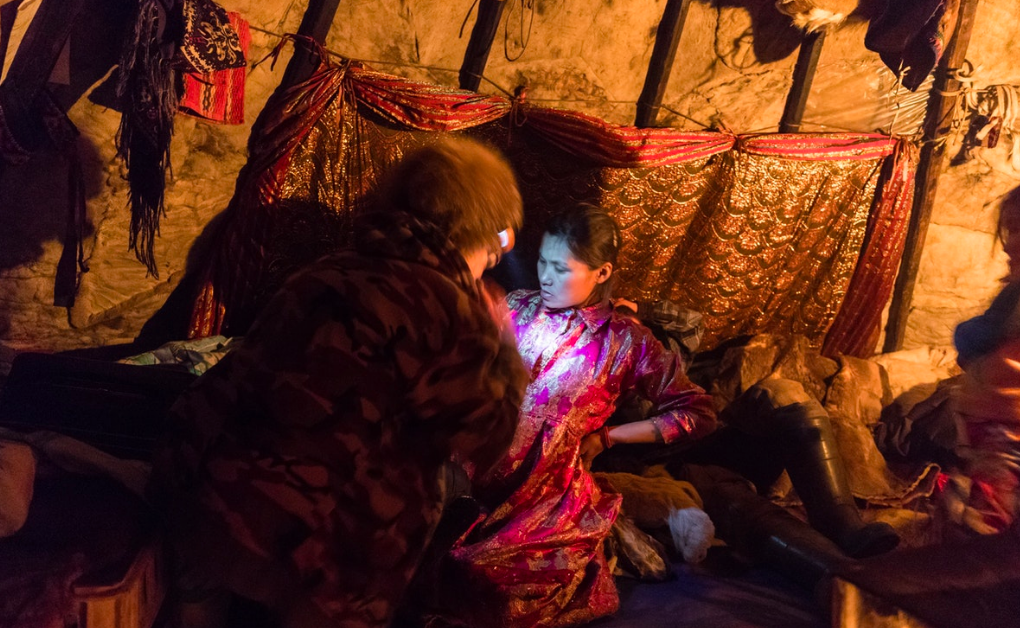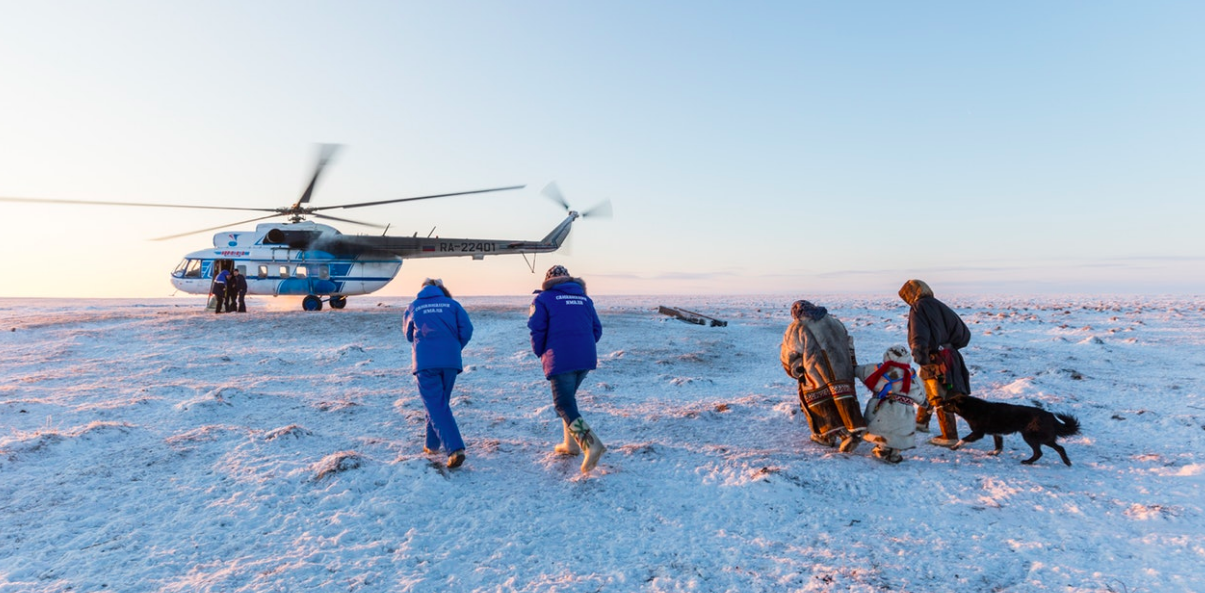For centuries, the nomadic Nenets reindeer herders of the Siberian arctic have migrated across one of the most challenging environments on Earth. Today, the permafrost is melting, posing significant threat to their unique way of life. This is the intimate story of Lena, a young Nenets mother, and her journey to birth.
Images © Alegra Ally / Words © Kim Frank
FIELD JOURNAL #1
I arrive in late autumn. The tundra seems vast and empty to the horizon. Only two dark pyramid-shaped “chums” (traditional Nenets’ tents) with tendrils of smoke rising from their tips stand out against the crisp blue sky.
No reindeer yet. Rather, I can hear the barking of dogs as they run between a chain of sledges. I look around, searching for the reindeer, but only the tundra greets me. As far as the eye can see, only brown earth and azure sky.
As I walk to explore the land, I discover the difficulty in moving before the land freezes and snow falls. It is very difficult to walk and I tire quickly, feeling much pain in my knees. The uneven ground makes it necessary to plan each step and the numerous water pods create muddy soft soil. We cannot travel any great distance in the sledge under these conditions as the reindeer are at risk of injury .
— October 21, 2016, Yamal Peninsula, Northwest Siberia
The Northern Lights arch high above the chum of the Khudi family, while sparks fly from the stove inside. Each year, the family must migrate to winter grazing lands with their reindeer, but without snow passage across the tundra is difficult to impossible. /prints available
FIELD JOURNAL #2
It’s my first morning in the chum, and I wake to unfamiliar surroundings. Whispering in a foreign language. I sneak a look from my warm sleeping bag and through the darkness I see the fur head cover of Lena. Above me dangles boots and clothing made of fur and reindeer hide. For a moment I’m overwhelmed with the knowledge that I will be spending the next fifty days living in these tight quarters with this family. I wonder how they must feel sharing their home with a stranger. These feelings are completely balanced with the knowledge that kindness, generosity, open hearts and gratitude are part of a universal language. No matter where we are born, we share these common human expressions. And so, the first moment we make eye contact, we are all sharing smiles.
— October 22, 2016, Yamal Peninsula, Northwest Siberia
Once the ground has frozen and a deep enough layer of snow has settled, Lena and her family can pack up their home and belongings onto their traditional wooden sledges, pulled by reindeer, and embark on their annual migration to find winter grazing lands for their herd. /prints available
“YAMAL” OR AT THE END OF THE WORLD
Living in small chums constructed of reindeer hides and log poles, and often separated from their nearest neighbor by a day’s snowmobile drive, the nomadic Nenets herders trek every winter along ancient migration routes across the vast Siberian tundra along the Yamal Peninsula. In their native language, “Yamal” means “the end of the world.” Herding hundreds of reindeer and surviving daily in extreme arctic conditions, many Nenets families maintain their traditions — adapting them, where useful and necessary, in response to the increasing pressures of their changing world.
Khudi family portrait. Left to right: Lena, her 4-year-old daughter, Christina, under blankets in the baby cradle, her newborn son, Phillip, and her husband, Leonya. Not pictured, the couple’s 9-year-old son, Ephim, who is currently attending the village boarding school.
Unfortunately, this environment is currently under strain from outside forces. The Yamal Peninsula contains one of the largest natural gas reserves on the planet. Following a succession of atypically hot summers, it appears that Siberia’s permafrost is melting at an unprecedented rate, posing a significant threat those who call this region home. As the permafrost melts, it is releasing millions of tons of carbon dioxide and methane into the atmosphere, damaging the Nenets’ traditional pastureland, threatening their reindeer herds and leading to increasingly unpredictable weather patterns. Widespread pipeline construction also disturbs their campsites, and passages across the land causing the loss of the Nenets’ traditional migratory patterns.
It is common for Nenets families to raise an orphan reindeer inside their chums, hand feeding the youngster until they are mature. Even after these reindeer return to the herd, the Nenets often maintain an intimate relationship with these particular individuals./prints available
I came to the Siberian tundra from mid-October through mid-December 2016 as a photographer and ethnographer to study and document the Nenets’ way of life. Specifically, I wanted to explore how a traditional Nenets family prepares for their winter migration, the ways that they have adjusted to modern life, and how their culture and values have shifted in the light of development and climate change.
At the heart of my expedition was the opportunity to document a Nenets woman’s ninth month of pregnancy and share her journey to birth.
NOVEMBER 10TH.
We’ve been waiting for snow for weeks. We need to migrate to the winter camp where the reindeer herd will have enough food and Lena’s family can settle in with their new infant. However, snow has been slow to arrive and the baby’s birth is impending. As with all births, planning on this timescale can be tricky. Lena and her husband, Leonya are hoping to minimize the duration that Lena is away from her critical domestic responsibilities as preparation for winter migration requires both men and women to be wholly engaged with activities for both daily sustenance and long-term survival.
The plan has been for Lena to contact the Helicopter Department at Salekhard hospital as she nears her delivery date. The helicopter will transport her and her daughter Christina to this hospital where she will stay for approximately two to three weeks to deliver her child and recover before returning by train, snowmobile, and sledge back to the chum, a journey that takes approximately twenty hours. Lena has once already sent the helicopter away when it arrived a month earlier to take her into the village.
Each day Lena can remain out on the tundra with her family is critical to their survival. Yet, time is running out and there is still much to be done.
Lena’s domestic responsibilities are crucial to support her family given the extreme environment. She must coordinate with the hospital helicopter service for pick up in advance of going into labor, but not too early as her ongoing presence out on the tundra is essential. /prints available
Regardless of her physical condition, Lena continues to accomplish her wide range of daily responsibilities. She is the first one to wake and the last to go to sleep. Every morning, she makes a fire, unties the dogs from their place in the chum and lets them outside. Then she sets about preparing the tea table for breakfast. After they eat, Leonya, who tells us to call him Leo, leaves to go work with their reindeer herd — the family has several hundred reindeer that are grazing many kilometers away.
Every day, Leo leaves the chum early in the morning, returns briefly for lunch, and goes back out with the herd until evening.
On Leo’s departure, Lena goes outside in the frigid temperatures to cut more firewood, a task I offer to help with, but am amazed to discover I am almost incapable to perform. Apparently, there is a technique to swinging an axe, one that even though I’m physically fit requires a practised swing over the shoulder. My attempts are near disaster as my upward swing threatens to take out everything and everyone behind me.
Even in her ninth month of pregnancy, Lena lifts the axe with a deftness I can only wish for — I am forced to leave the chopping to her.
Lena locates, gathers, and chops all the wood that is needed to keep the fire burning at all times inside the chum. With winter temperatures that can reach -50°c, these tasks are essential for the family’s survival and well-being.
I can help by bringing the firewood inside, as Lena’s morning is filled with other responsibilities: beating the fresh fallen snow off the chum walls, splitting the chimney to empty the black particles left behind by the smoke, gathering items from the various sledges, and collecting water from the reservoirs. These have become iced over, requiring Lena to break them open with a pole to reach the water beneath. Once inside again, she prepares food for, then feeds, the dogs, and then cooks a meal for lunch.
Lena fills her free time with making clothes for her family. Each item of a Nenets’ winter costume is taken from a specific part of the reindeer. For example, the hides used for boots are cultivated in middle of the winter to ensure the thickest fur.
All the while, Lena is taking care of Christina, who is remarkably content occupying herself with found objects and the ice pods, her favourite. I grow to love this small child, and spend many hours playing with her.
Four-year-old Christina is at home with the cold. Her favorite part of the tundra playground? The multiple pools of water as they begin to freeze and become ice pods. /prints available
NOVEMBER 18TH
The ice layer has thickened during the past three days and Leonya says that he would like to start the migration in a couple of days, this will be the sixth time since my arrival that the family has attempted to migrate. To prepare, the several hundred reindeer must be herded into a tight circle for traveling. This requires Lena’s assistance to handle the dogs on leashes as they circle the herd, dogs barking. While the men lasso the herd, Lena helps by circling approximately a thousand reindeer, managing a large dog tethered to a long leash for several hours to keep the herd together until the lassoing is finished.
Although the family’s dogs must work hard, and make an important contribution to the Nenets’ ability to survive out on the tundra with their reindeer, they also provide affection and an occasional playmate for four-year-old Christina.
The dog barks and in his enthusiasm runs around, tugging the leash and making the work even more difficult, as Lena has to continue pulling him back and controlling the pace of the walk. It is extremely tiring work which requires constant attention as well as physical strength and agility. I try it and am amazed at how difficult it was to keep the dog away from the herd. After only a couple of rounds I am utterly exhausted. Towards the end the dog is pulling so hard that Lena slips and falls on her stomach. We reach her almost immediately, extremely worried. But she gets up quickly, smiles, and assures us she is okay. She continues until the job is complete.
Days away from giving birth, Lena works to herd the reindeer into a tight circle in preparation for migration.
As well as documenting Lena’s final weeks of pregnancy and birth, taking part in the Nenets’ traditional winter migration with their reindeer is one of the primary reasons for my visit during this time of year. But, because of the unseasonable weather conditions, the tundra has not been ready for us to make the trip. We’ve been waiting for over thirty days for enough consistent freeze and snowfall to make the migration route possible.
Earlier this month, I rode the sledge for five hours to reach the nearest village, in order to recharge my camera batteries.
The pain from the cold to my feet and my fingers was almost unbearable, and if not for the medical expertise of the local Nenets woman minding the supply shelter, I would likely have suffered from severe frostbite.
My plan for our migration is now to wrap my feet and hands with several layers of fur and felt blankets to make sure the wind is not penetrating my skin. I have realised this means that I will not be able to photograph during the actual migration, as Leoyna has insisted I must be fastened to the sledge with ropes for safety, so I will have no workable use of my limbs.
Handmade wooden sledges have been used by generations of Nenets as an efficient way to transport their belongings across the vast expanses of frozen tundra. Reindeer pull the often heavily-laden sledges, while the dogs guide alongside.
I am still able to capture the activities as the family prepares for migration: lassoing the reindeer, unpacking and repacking sledges, preparing the caravan and disassembling the chum. Yet, while I was so eager to take part in the actual winter migration, I am disappointed to realise I will not be able to take photographs while actually travelling on this journey. I must take extreme care to protect my camera gear. Although it will be secured on the sledge and wrapped in fur, the strong winds and significant temperature drops put the equipment at risk.
I will need to carry all ten batteries on my body the entire time in order to keep them warm or else they will drain rapidly due to the cold.
As the seasons change, Nenets families change their chum coverings from light summer skin to thick fur hide. Passed down through generations, the winter cover consists of four layers of reindeer skin, stitched by hand over a whole year, from more then one hundred reindeer.
Lena tells us that she will contact the helicopter to pick her up a day earlier than planned, as she feels her delivery is impending. Our plan is to migrate now and then when we are set up in the new camp, the helicopter will come retrieve her to make the transfer to the hospital. The railways have been placed along the ancient migration routes, disrupting the migration patterns, but also providing an unintended benefit. There is cell reception within two kilometers of the tracks, and Nenets families now typically set up camp within short distances so they can access cellular service in an emergency.
Among the belongings the Khudi family carry from camp to camp is this small box containing special items such as religious cards, family treasures, and photographs.
NOVEMBER 2OTH.
At two am on the day we are supposed to begin the migration, Leo wakes me from a sound sleep. Lena is experiencing pain in her lower abdomen and believes they are contractions. Leo has called the village from his mobile phone and asked them to contact the helicopter in Salekhard.
However, the helicopter cannot fly during the night so they have set arrival for daybreak, which at this time of year does not occur until almost 10am. They have advised us to send for the nurse at the closest trading station, but reception is here is faulty and now we can no longer get through, even when we attempt to communicate with my sat phone. Leo ends up walking a moonlit, but bitter cold two kilometers to the train tracks where he can get more reliable cell service. On his way back, he alerts his relative, Igor, whose family’s chum is nearby. Igor takes off in his snowmobile to pick up the nurse approximately two hours away.
By three-thirty, Lena clearly needs medical support and Leo is worried.
He wants to contact the helicopter department again and try to convince them to make the night trip, with the logic that the full moon will provide the necessary light and that the chum is close enough to the railways, so it will be an easy landmark for the pilots to follow until the flashing of the snowmobile lights that Leo will use to guide the helicopter to the chum.
In the commotion, Christina wakes up and asks what is happening. She is not aware that her mother is pregnant and her parents have decided not to tell her beforehand because they believe she will be jealous. In just a few hours she will be taken with her mother on a helicopter to the village hospital and temporarily placed in a child welfare center. She is aware of none of this and I worry for her, even as there is no other solution. Without her mother to care for her, Christina cannot stay on the tundra.
The elements are no match for traditional Nenets’ winter costume. Dressed properly, Christina can play outside for hours./prints available
We are all now awake and waiting. Not one to panic in crisis, Lena begins to carefully pack her belongings. In addition to her personal necessities, she takes sewing tools, small boots, and scraps of fur so she can work while she is in the hospital. When she is ready, Lena turns to me and Zalphira, my translator and asks us what we are going to do now, after she is gone.
At the heart of the Nenets’ chum is the stove. Lena must constantly ensure there is adequate fuel to keep her family warm, and uses the stove for all essential household needs, such as cooking and cleaning.
Then it hits me, the depth to which we simply cannot survive here without Lena. Even the most basic acts for surviving in this landscape, such as making sure there is always a fire to keep us warm means not just placing fuel in the stove, but, with no other fuel, determining where and how to find wood when it is buried in the ice and snow. When supplies are exhausted in the near vicinity, how do we travel to the outlying areas to search for and collect more? This is only one basic element of the chores Lena tends to daily. Preparing food and cooking in this environment are skills that take time to learn and Leonya will not be able help as he is wholly tending to the herd.
Each member of a traditional Nenets family has specific responsibilities that together are essential to their collective survival on the tundra. While, Leo tends to the reindeer herd out on the tundra, Lena cares for their four year old daughter, Christina.
Thankfully, we have an answer to Lena’s question. Our hope is to travel by helicopter and accompany her to Salekhard. Barring this opportunity, we will hire a truckle and drive the twelve hours to the village by sledge and snowmobile, where I will document Lena’s birth experience in any way I can.
There is nothing left to do now but wait and for the next two hours we all try to get some rest. I wake again to the sound of a fire starting. Though experiencing contractions, Lena remains committed to her responsibility as a mother, a wife, and also a host. While we are all still resting and anticipating, she gets up and places more wood in the stove to warm water for tea. It’s seven a.m and still dark outside. We wonder who will arrive first — the nurse or the helicopter.
We don’t have to wait long for our answer, as after our first sips of tea, the increasing buzz of a snowmobile sounds off in the distance. A few moments later, after traveling for several hours on a box sledge, Galina, the nurse, arrives. She wastes no time and Galina’s first communication with Lena is to firmly ask, “Why didn’t you go to the hospital a month ago?” Galina then checks her blood pressure and asks when Lena last had an ultrasound to check the baby’s position. After a full check-up, Galina and Leo set off for the railways to attempt another communication with the helicopter department.
In the early hours of the morning, on the day the family had finally planned to begin their migration, Lena experiences her first contractions. By 7:30 am Galina, a nurse from the closest trading station, two hours away, arrives to assist Lena.
Finally, the sun has risen, it’s ten am and the helicopter’s hovering presence overhead is a thunderous contrast to the daily stillness we have grown accustomed to. The pilot circles us twice then prepares to land.
The entire process happens surprisingly fast. Upon landing, two officials and nurses jump out and approach Lena and begin to load her and Christina into the helicopter. Christina pulls back, frightened, but her father walks the family to the opening and sees them off. I was not permitted to accompany them as I had hoped. Just like that they are gone.
At dawn, the helicopter arrives to collect Lena, and a frightened, resistant, Christina.
The tundra is eerily silent when the helicopter departs. Without Lena and Christina, the entire landscape feels abruptly stark and lonely.
When we enter the chum it feels empty not only of bodies, but also of energy, and spirit. Outside, the sledges are packed and ready to travel for migration. But, without Lena we cannot move. It will be at least two weeks before she returns with her newborn and Christina. Everything must be unpacked and migration will be postponed. This could put the herd in jeopardy, as quality-grazing areas are difficult to come by, with the most sought after spots taken by the earliest migrating Nenets with the largest herds.
In order to migrate, the eight hundred reindeer that make up the herd must be corralled into a tight circle
Although their migration has now been temporarily suspended, Lena has successfully reduced the time she will be away from her family. When she returns with Christina and their newborn son, the family will move their herd to a winter camp. /prints available
Zalphira and I recognize that we cannot possibly stay and survive without Lena. Yet, I wonder how Lyonya will manage without his partner, how will he possibly prepare food and keep the chum from freezing when he is required to be out with the reindeer herd for long hours?
One of many lessons I’ve learned during my time here is that the unexpected is every day. You can’t control a sudden snowstorm, a sick reindeer, or rain in November, but the way you prepare for possibilities and how you adapt to change are the keys to survival.
This was the day we prepared to migrate, and instead it is the day Lena and Leonya’s child will be born. As the sun finds its place briefly overhead, I understand that the journey I will take now, while not planned, is something I’m prepared for. We will travel eight hours by sledge and then snowmobile back to the village where Lena is about to give birth. There I will wait and gather stories. The reindeer stand like stoics, painstakingly herded and ready to go. Their puffs of cloud breath visible against the crisp blue sky.
—
WOMEN AT THE END OF THE LAND: THE BOOK
This story is part of a longer narrative that will be published in the forthcoming photography book, Woman at the End of the Land. A close collaboration with writer Kim Frank, this book will share a rich and detailed glimpse into Lena’s birth journey, as well as explore my experiences documenting the Nenets’ daily lives at a time of great change in their history, when rapid climate change and industrial development pose a significant threat to their unique way of life.
KIM FRANK is an award-winning writer and editor, whose work is published around the globe. Part of the Maptia Editorial team, her eye for story and gifted prose brings exploration, adventure, and conservation to light.
THIS ARTICLE WAS ORIGINALLY PUBLISHED ON MAPTIA
























